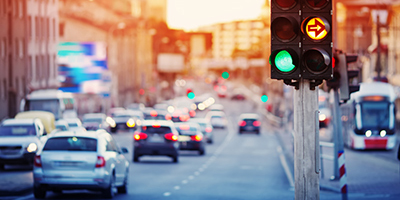 There are currently 1.3 billion cars on the road, but that’s nothing compared to over 2 billion automobiles that will be in use by 2040. Unfortunately, our road networks are likely not equipped to deal with this massive influx of vehicles. Traffic jams already affect medium and big cities across the world, and if nothing changes, it’s reasonable to assume the situation will only get worse.
There are currently 1.3 billion cars on the road, but that’s nothing compared to over 2 billion automobiles that will be in use by 2040. Unfortunately, our road networks are likely not equipped to deal with this massive influx of vehicles. Traffic jams already affect medium and big cities across the world, and if nothing changes, it’s reasonable to assume the situation will only get worse.
However, a solution is in the works to ease congested traffic. By combining communications technology with artificial intelligence (AI) functionality, intelligent traffic systems will use machine vision to free up congested roads.
Modern Fixes for Modern Traffic Problems
Modern traffic management systems use a combination of cameras and sensors in the road to assess vehicle density. But to find new avenues for improvement, researchers continue to explore how traffic management systems can become more dynamic and responsive through the use of AI and machine vision. To cure city traffic woes, intelligent traffic systems are devised to detect vehicles and send information to a central control station. There, algorithms estimate the density of road congestion and trigger traffic light changes based on real-time traffic data.
In particular, Pittsburgh began testing an intelligent traffic system in 2012. The traffic system, installed in 50 intersections in the city, has reduced wait times by around 40%, travel times by 25%, and emissions by 20%.
A Solution to the Challenges of Outdoor Imaging
Nearly every imaging application related to traffic concerns is outdoors, but advanced cameras are often unfit to capture high-quality images in variable lighting. Understandably, low-light conditions usually produce noisy and low-quality images. But on the other end of the spectrum, high-light conditions produce images that are too bright and show glare. Neither situation is ideal for these traffic systems.
Nevertheless, JAI cameras like the Spark 10-GigE Camera with AMS CMV12000 provide an excellent solution to outdoor imaging concerns. The applicable benefits of this camera for intelligent traffic systems include high performance, high speed, and high resolution. At full resolution, the camera reaches 84 frames per second. In addition, the 10-GigE area scan camera offers color, monochrome, and near-infrared imaging, making it a particularly versatile option.
Camera applications commonly required for these systems include open road tolling, automatic license plate readers (LPR), law enforcement, and monitoring and transportation. Additionally, these cameras can be used in similar applications on railroads.
For help finding the right JAI 10-GigE camera for your application, speak with the industrial camera and component experts at Phase 1 Technology.
